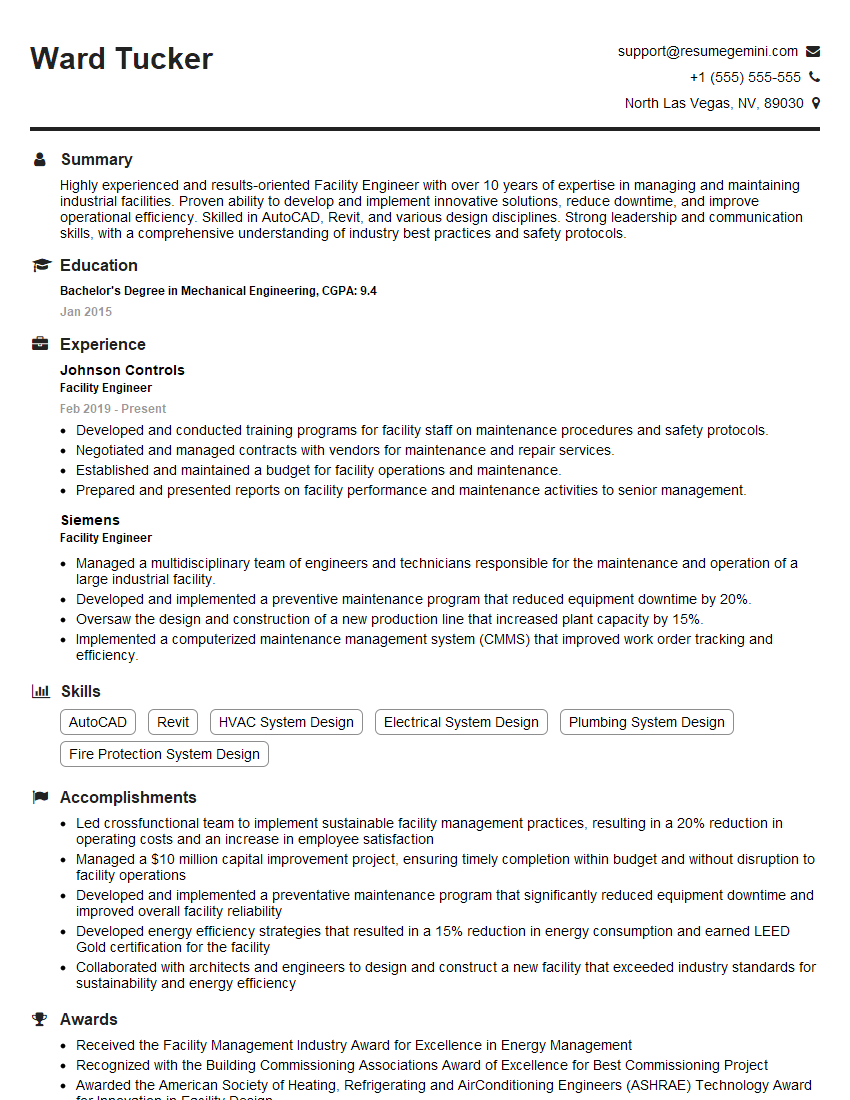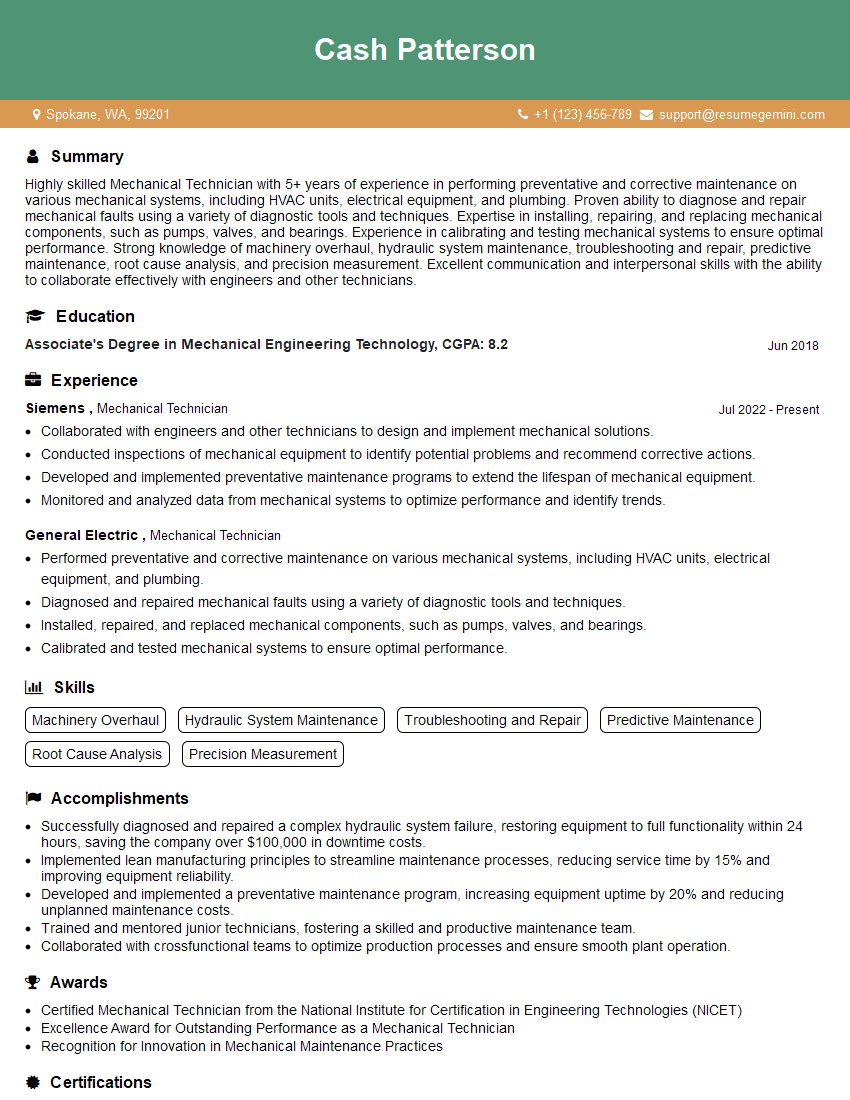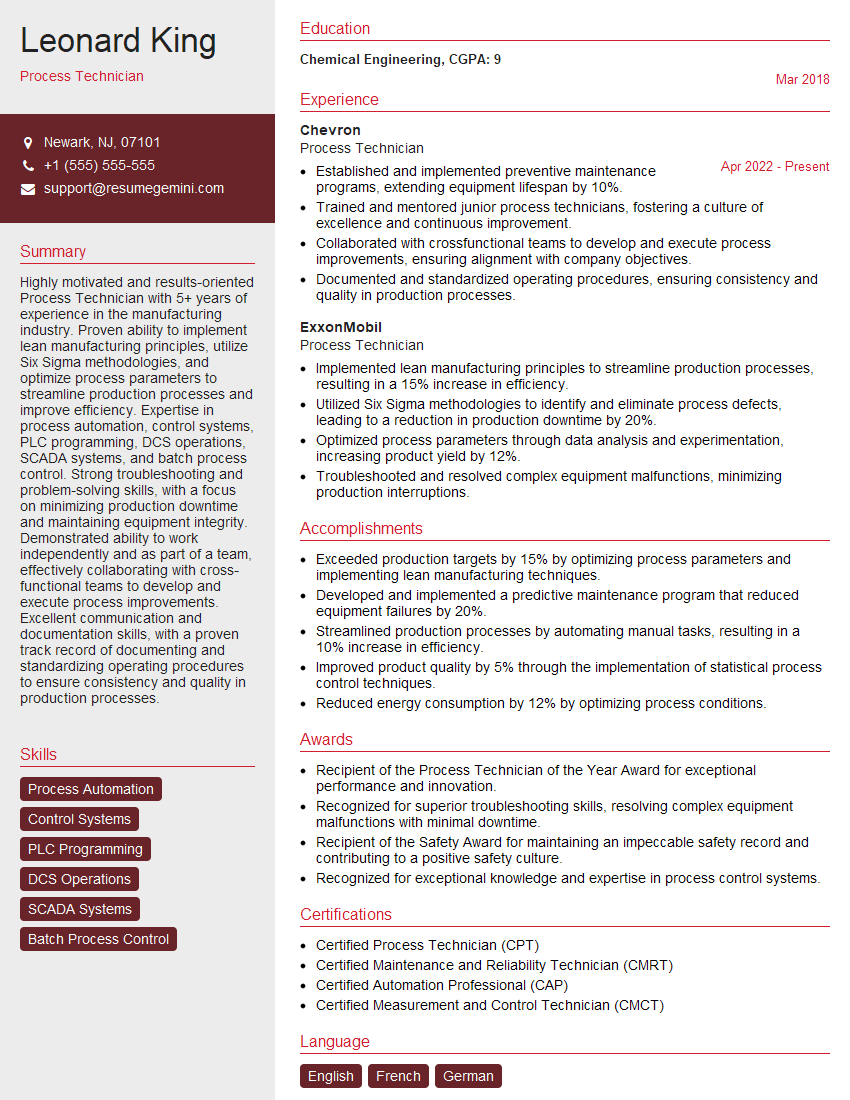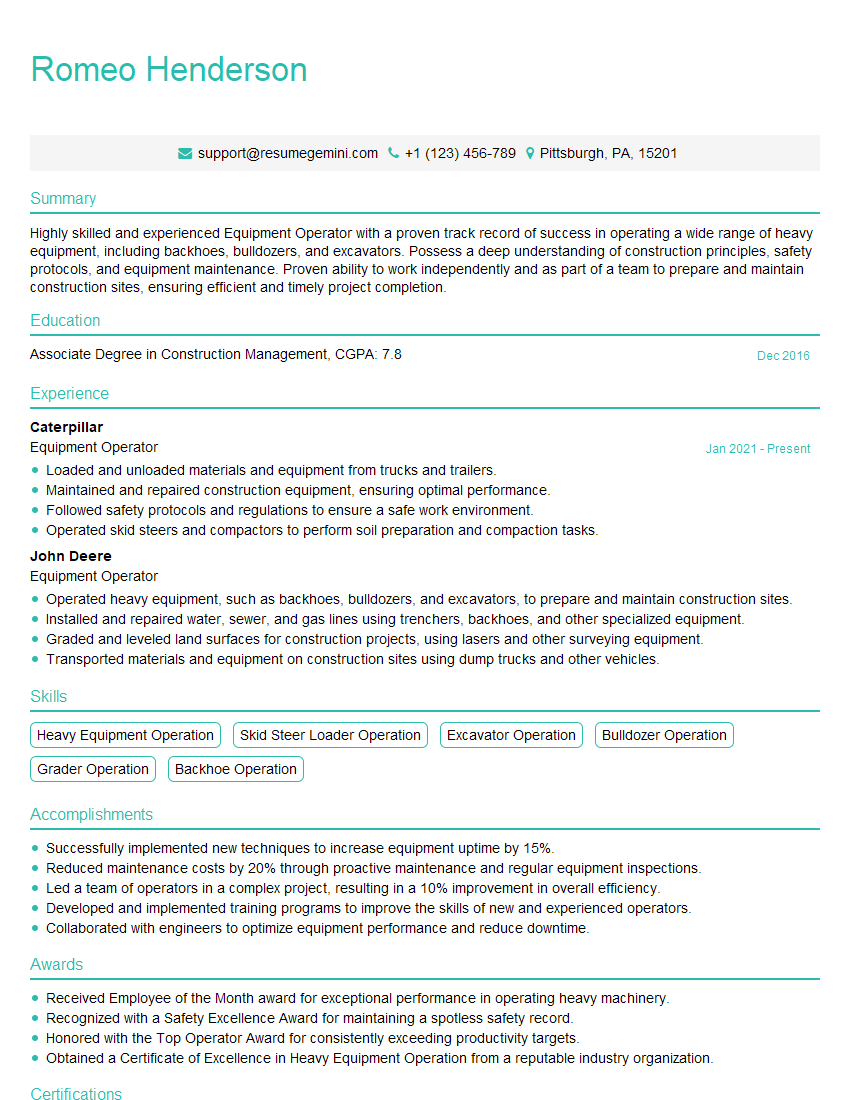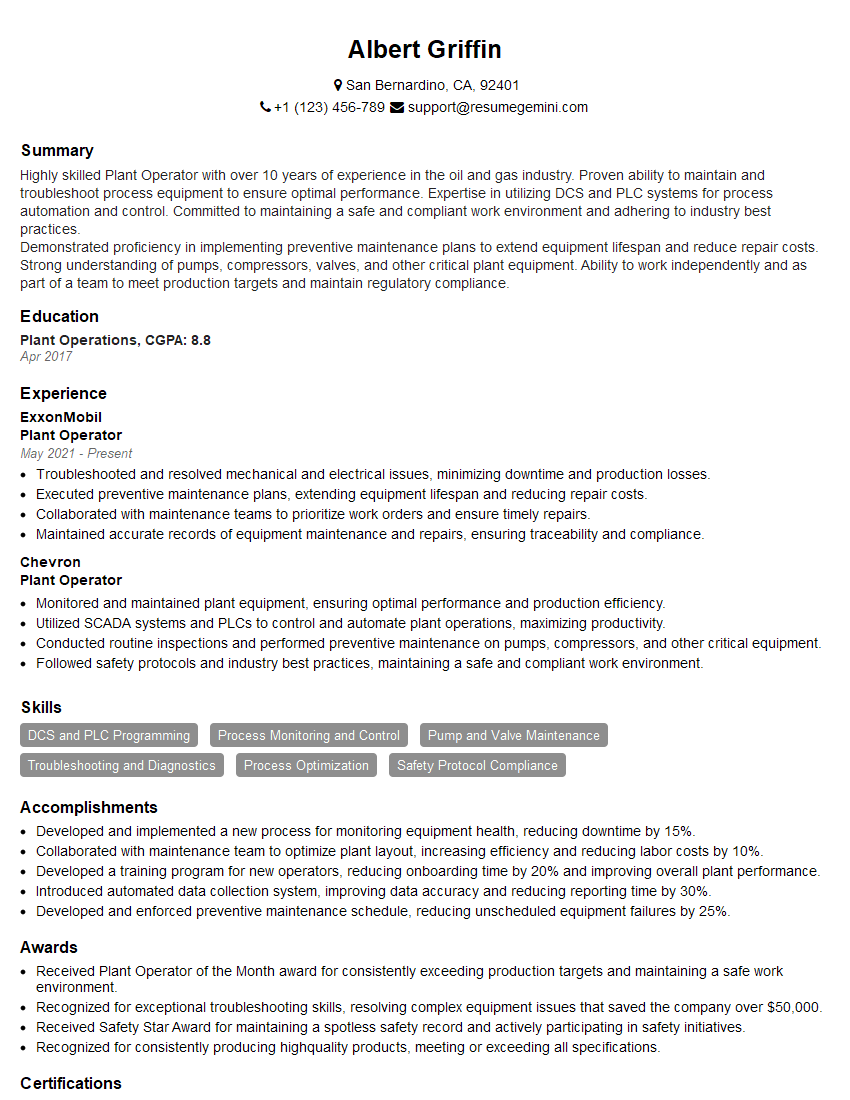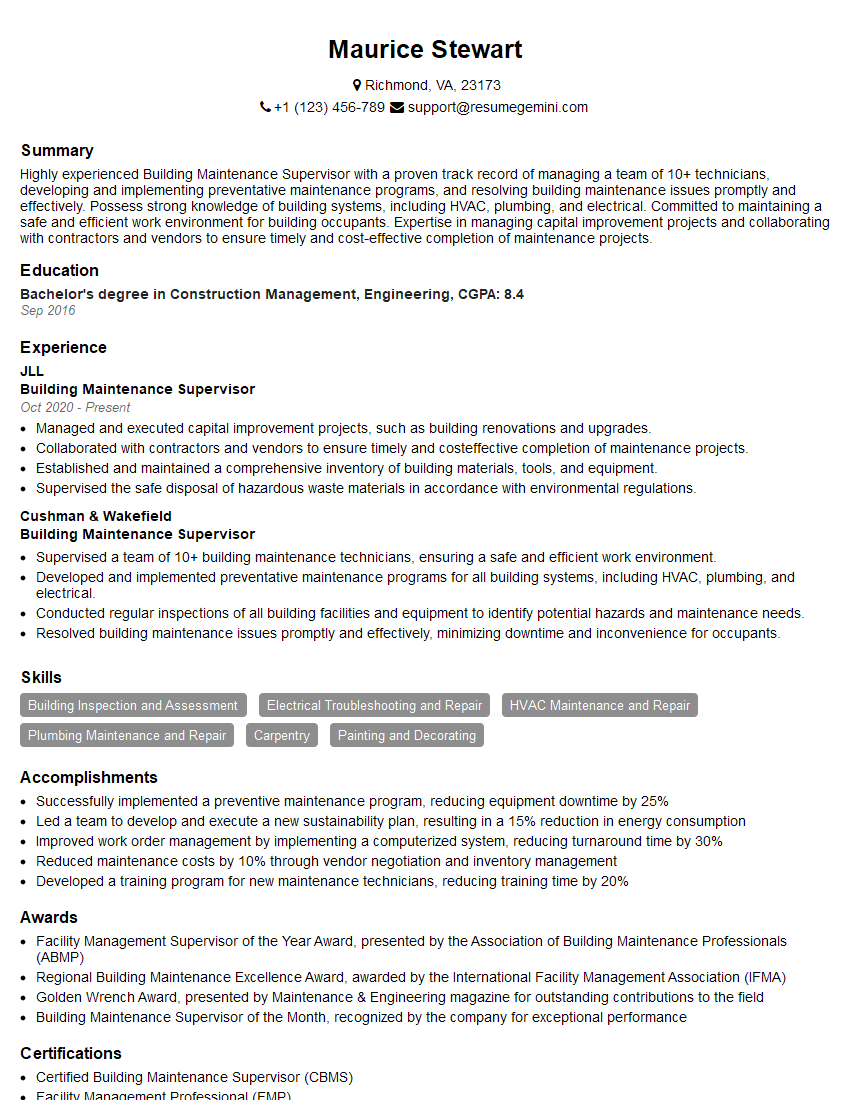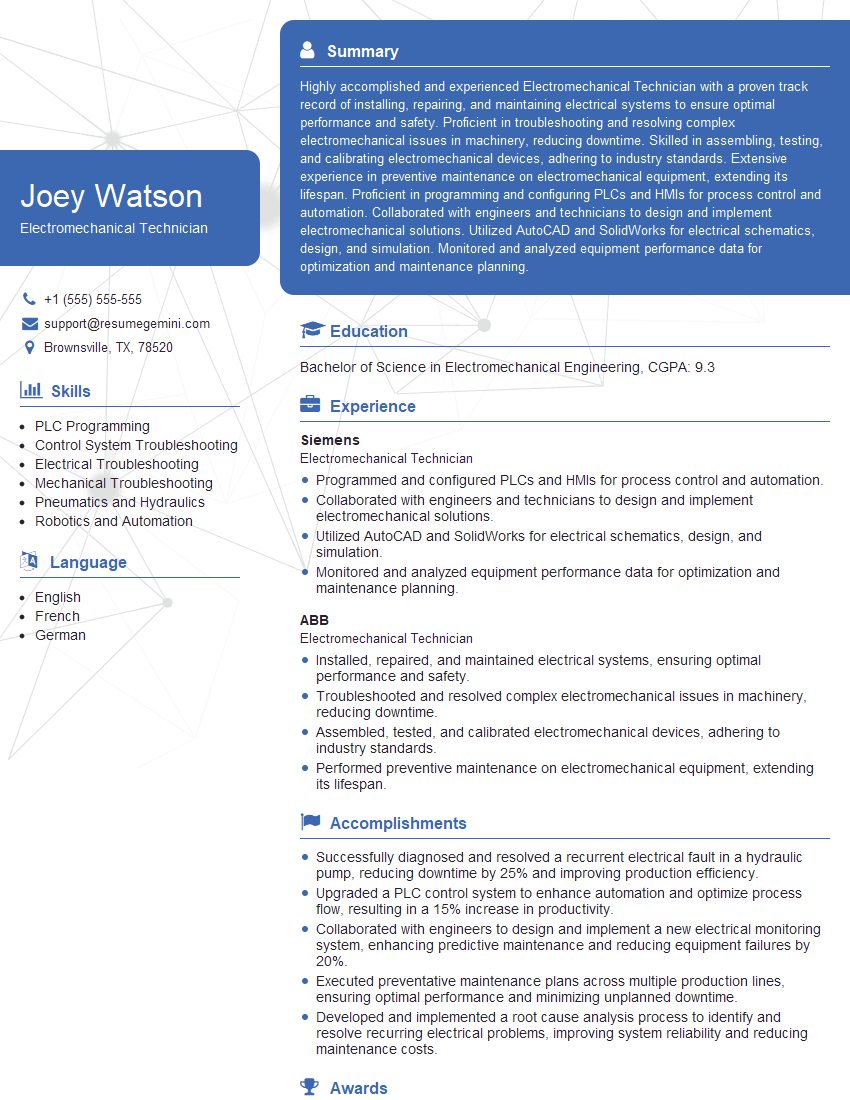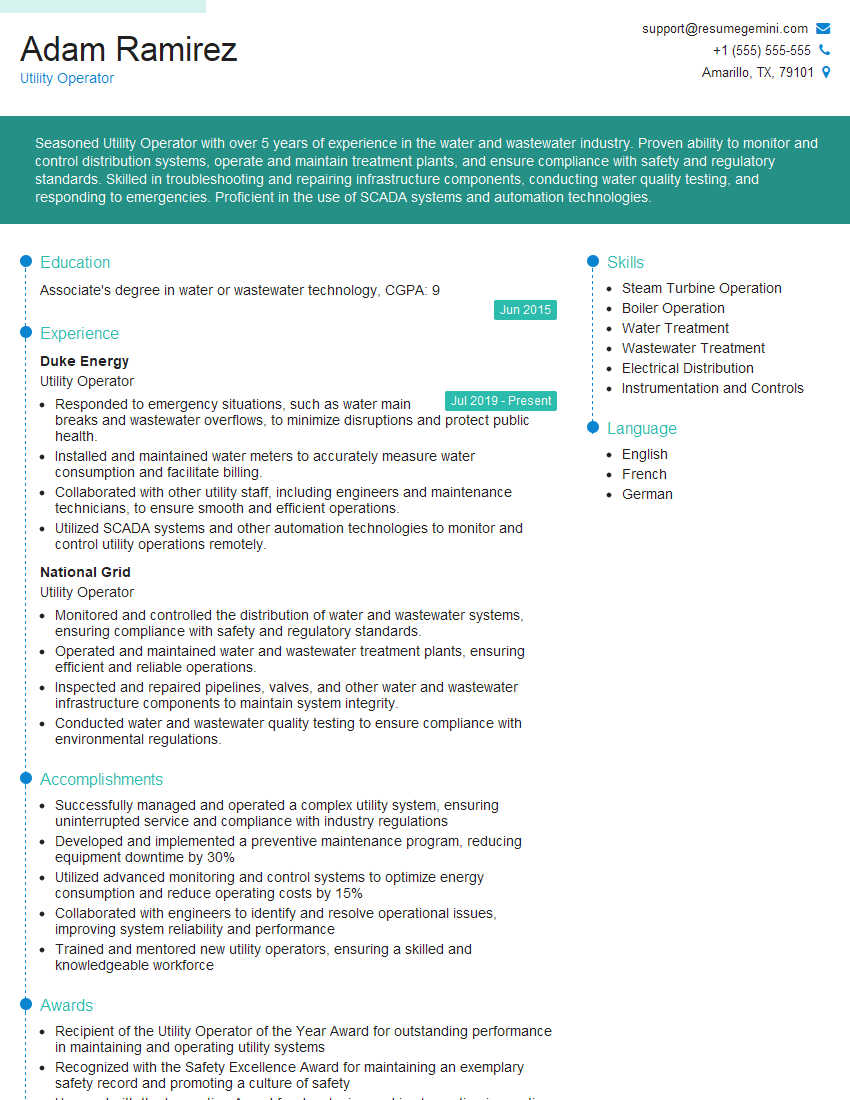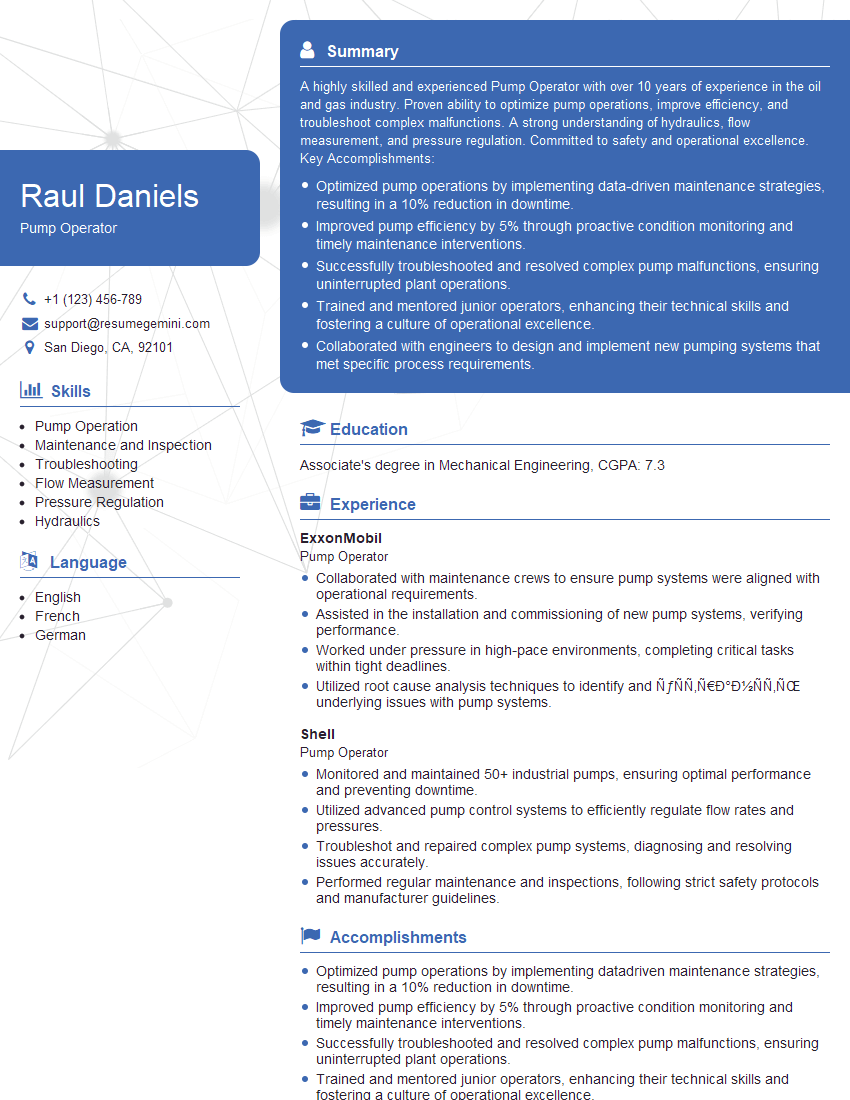Interviews are opportunities to demonstrate your expertise, and this guide is here to help you shine. Explore the essential Equipment Operation (Pumps, Dehumidifiers, Air Scrubbers) interview questions that employers frequently ask, paired with strategies for crafting responses that set you apart from the competition.
Questions Asked in Equipment Operation (Pumps, Dehumidifiers, Air Scrubbers) Interview
Q 1. Explain the different types of pumps and their applications.
Pumps are broadly categorized based on their operating principles. Understanding the nuances of each type is crucial for selecting the right pump for a specific application. Here are some key types:
- Centrifugal Pumps: These are the most common type, using a rotating impeller to increase the velocity of the fluid. They’re ideal for high-flow, low-pressure applications like water supply systems and irrigation.
- Positive Displacement Pumps: These pumps trap a fixed volume of fluid and force it through the discharge. They are used where high pressure and precise flow rates are needed, such as in chemical processing or hydraulic systems. Sub-types include:
- Reciprocating pumps: Use pistons or diaphragms to create the pumping action.
- Rotary pumps: Use rotating elements like gears, lobes, or screws to move the fluid.
- Diaphragm Pumps: These use a flexible diaphragm to move the fluid, making them suitable for handling viscous or abrasive fluids and applications requiring precise flow control, like dispensing chemicals.
- Submersible Pumps: These pumps are located underwater, ideal for pumping water from wells or sumps.
The choice of pump depends heavily on the fluid properties (viscosity, abrasiveness), required flow rate, pressure, and budget. For instance, a centrifugal pump might be ideal for pumping large volumes of water, while a positive displacement pump would be better suited for transferring high-viscosity oil at high pressure.
Q 2. Describe the working principle of a centrifugal pump.
A centrifugal pump works by converting rotational energy into fluid energy. Imagine a spinning pinwheel throwing water outwards. The impeller, a rotating disc with curved blades, acts like that pinwheel. As the impeller spins, it accelerates the fluid towards the pump’s outer edge. This increased velocity translates into higher pressure, enabling the fluid to be discharged through the outlet pipe. The pressure difference between the inlet and outlet creates the flow. The shape of the impeller and the pump casing are carefully designed to optimize this process and achieve the desired flow and pressure.
Think of it like this: the impeller gives the fluid a boost of kinetic energy (speed), and the pump casing converts that kinetic energy into potential energy (pressure). This pressure differential drives the flow of the fluid.
Q 3. How do you troubleshoot a pump that is not delivering sufficient flow?
Troubleshooting a low-flow pump involves a systematic approach. Start by checking the obvious:
- Check the power supply: Ensure the pump is receiving adequate power. A blown fuse or tripped breaker can cause a complete failure or reduced output.
- Inspect the inlet and outlet lines: Look for blockages, leaks, or kinks in the piping. A clogged inlet will severely restrict flow. A leak after the pump reduces the effective discharge pressure.
- Check the pump’s suction lift: The pump might be trying to draw fluid from a height greater than its capabilities, leading to inadequate flow. The suction lift is determined by the pump design and installation.
- Examine the impeller: Inspect the impeller for wear, damage, or debris buildup. A worn impeller reduces its effectiveness at accelerating the fluid.
- Verify the pump’s prime: Centrifugal pumps require a prime (filled with fluid) to operate correctly. If air is present, the pump may not function properly.
- Check the bearings: Worn bearings can cause the impeller to rotate inefficiently, reducing flow.
- Measure the flow rate: Use a flow meter to quantitatively assess the actual discharge rate against the expected or rated value to confirm the issue and its severity.
By methodically checking these points, you can usually pinpoint the source of the problem.
Q 4. What are the common causes of pump cavitation?
Cavitation is the formation of vapor bubbles within a liquid due to low pressure. It occurs when the pressure within the pump falls below the vapor pressure of the fluid. These bubbles collapse violently as they move to areas of higher pressure, causing damage to the pump’s internal components. Think of it like tiny explosions inside the pump.
- Low inlet pressure: If the liquid isn’t readily available at sufficient pressure, it creates a vacuum which causes cavitation. This is why proper suction lift is essential.
- High discharge pressure: Excessive discharge pressure can also contribute to low internal pressures.
- High liquid temperature: A high liquid temperature reduces its vapor pressure, making it more prone to cavitation.
- Partial blockage: Any restriction in the inlet line can reduce the flow to the pump causing insufficient liquid supply and resulting in cavitation.
- Pump wear: A worn or damaged impeller can cause cavitation because it reduces the fluid’s pressure gradient.
Cavitation leads to noise, vibration, reduced efficiency, and premature pump failure, so addressing its root causes is important. It can be heard as a rattling or hammering sound and manifests through reduced pump performance.
Q 5. How do you maintain a centrifugal pump to ensure optimal performance?
Regular maintenance is crucial for prolonging a centrifugal pump’s lifespan and ensuring optimal performance. This includes:
- Regular Inspections: Visually inspect the pump for leaks, wear and tear, and any signs of damage. This includes checking the pump casing, seals, shaft, and couplings.
- Lubrication: Lubricate bearings and other moving parts according to the manufacturer’s recommendations to minimize friction and wear.
- Bearing Replacement: Worn bearings significantly reduce efficiency and can lead to premature failure. Replace them as needed.
- Seal Replacement: Pump seals are prone to wear and tear. Replacing them prevents leaks and extends the pump’s life.
- Cleaning: Regularly clean the pump’s inlet and outlet lines to remove any blockages. This prevents cavitation and maintains efficiency.
- Impeller inspection: Inspect the impeller for wear, erosion, or damage. Consider impeller replacement if necessary.
- Vibration Monitoring: Regularly monitor pump vibrations using vibration sensors. Excessive vibrations are a sign of problems that can quickly lead to failure.
Following a preventative maintenance schedule, including detailed logging of any issues or repairs, is critical for minimizing downtime and ensuring long-term performance.
Q 6. Explain the function of a dehumidifier.
A dehumidifier’s primary function is to remove moisture from the air. Think of it as a reverse air conditioner: instead of cooling the air, it reduces the humidity levels. This is achieved by extracting water vapor from the air, making the environment drier and more comfortable. This is beneficial in combating mold and mildew growth, preventing damage to building materials, and creating a more comfortable environment for people with respiratory issues.
In many industrial settings, dehumidification is crucial to prevent damage to sensitive equipment or materials that can be affected by moisture. For instance, in data centers or museum archives, maintaining a specific humidity level is vital for equipment operation and preservation of delicate artifacts.
Q 7. What are the different types of dehumidifiers?
Dehumidifiers come in several types, each with its own strengths and weaknesses:
- Desiccant Dehumidifiers: These use a desiccant material (like silica gel) to absorb moisture from the air. They’re effective even at low temperatures and can remove a larger volume of water compared to other types. They are often preferred in colder climates.
- Refrigerant Dehumidifiers: These function similarly to air conditioners, using a refrigerant to cool the air below its dew point, causing moisture to condense and be collected. They are generally more energy-efficient in warmer climates.
- Thermoelectric Dehumidifiers: These use the Peltier effect to cool and condense moisture. They are often smaller and quieter but less powerful than the other types.
The best type of dehumidifier depends on the specific application, climate conditions, and budget. For example, a desiccant dehumidifier is useful in basements or crawlspaces where temperatures are often low, while a refrigerant dehumidifier would typically be better suited for humid, warm climates.
Q 8. How does a desiccant dehumidifier work compared to a refrigerant dehumidifier?
Desiccant and refrigerant dehumidifiers employ different methods to remove moisture from the air. Refrigerant dehumidifiers work similarly to a refrigerator. They use a refrigerant to cool a coil below the dew point, causing moisture in the air to condense on the coil and drain away. Think of it like a cold glass sweating on a humid day – the same principle applies. Desiccant dehumidifiers, however, use a desiccant material, usually silica gel or zeolite, to absorb moisture directly from the air. This material is then heated, usually by an electric element, to release the trapped moisture. This makes them more effective at very low temperatures or high humidity levels where refrigerant dehumidifiers struggle.
In short: Refrigerant dehumidifiers condense moisture, while desiccant dehumidifiers absorb it.
Example: A refrigerant dehumidifier is ideal for a typical basement dehumidification, while a desiccant dehumidifier might be preferred in a cold storage facility where the air is already quite chilly.
Q 9. How do you troubleshoot a dehumidifier that is not removing enough moisture?
Troubleshooting a dehumidifier that isn’t removing enough moisture involves a systematic approach. First, check the obvious: is the unit plugged in and turned on? Is the unit’s bucket or drain line full? A full bucket will stop the dehumidification process in most models. Next, examine the filter (if present). A clogged or dirty filter restricts airflow, reducing the dehumidifier’s efficiency. Clean or replace it as needed.
Then, consider the room’s environment. Is the humidity level exceptionally high, or is there a significant source of moisture, like a leaky pipe or ongoing construction?
If these checks don’t solve the problem, consider these steps:
- Check the coils (refrigerant dehumidifiers): Ensure the coils are clean and free of debris. Dust or grime can impair their ability to condense moisture.
- Check the desiccant (desiccant dehumidifiers): While you generally can’t service the desiccant yourself, frequent cycles of the dehumidifier may point to possible desiccant degradation; consult a service manual or professional.
- Inspect the fan: A malfunctioning fan can drastically affect air circulation and dehumidification.
- Examine the compressor (refrigerant dehumidifiers): A failing compressor may be the culprit. This usually requires professional repair.
If the problem persists after these steps, it’s best to call a qualified technician.
Q 10. What are the common maintenance tasks for a dehumidifier?
Regular maintenance is key to extending the lifespan and optimizing the performance of a dehumidifier. Here are some common maintenance tasks:
- Regularly empty the water tank or check the drain line: Avoid overflowing. This is the most crucial task!
- Clean or replace the air filter (if applicable): A dirty filter hinders airflow and reduces efficiency. Consult your owner’s manual for the recommended cleaning schedule.
- Clean the coils (refrigerant dehumidifiers): Gently clean the coils using a soft brush or vacuum to remove dust and debris. Do not use water or harsh chemicals.
- Inspect the unit for any signs of damage or wear: Look for cracks, loose parts, or any indication of a problem.
- Check for proper ventilation: Ensure the dehumidifier has adequate space around it for proper airflow.
- Store properly during off-season: Allow the unit to dry completely before storing to prevent mold growth.
Remember to always consult your dehumidifier’s owner’s manual for specific instructions and recommendations.
Q 11. Describe the purpose of an air scrubber.
An air scrubber is a specialized type of air purifier designed to remove airborne contaminants such as dust, mold spores, bacteria, viruses, and volatile organic compounds (VOCs). They are often used in areas requiring strict air quality control, such as construction sites, mold remediation projects, or after a fire. They go beyond simple filtration, often including methods to control and contain the spread of harmful particulates.
In essence: Air scrubbers actively clean the air, removing a broader range of pollutants than standard air purifiers.
Example: After a building fire, an air scrubber is employed to remove soot and smoke particles from the air, creating a safer environment for cleanup and restoration.
Q 12. What are the different types of air scrubbers?
Air scrubbers come in various types, each tailored to specific applications and contaminants:
- HEPA air scrubbers: These utilize High-Efficiency Particulate Air (HEPA) filters to capture microscopic particles.
- Carbon air scrubbers: These employ activated carbon filters to adsorb gases and odors.
- HEPA/carbon combination air scrubbers: These combine the benefits of both HEPA and carbon filtration for comprehensive contaminant removal.
- UV air scrubbers: These utilize ultraviolet (UV) light to kill bacteria and viruses.
- Negative air pressure scrubbers: These are used in containment scenarios to prevent the spread of contaminants to other areas, often employed during asbestos abatement.
The choice of air scrubber depends on the specific contaminants present and the desired level of air quality.
Q 13. How does a HEPA air scrubber work?
A HEPA air scrubber works by using a High-Efficiency Particulate Air (HEPA) filter to remove particles from the air. HEPA filters are composed of a dense, pleated material with incredibly small pores. These pores are so small that they trap particles down to 0.3 microns in size, capturing a significant percentage (99.97%) of airborne contaminants, including dust, mold spores, pollen, and pet dander. The air is drawn into the scrubber, passes through the HEPA filter, and then the cleaned air is released back into the environment. This process is continuous and effectively removes tiny pollutants that could otherwise circulate in the air.
Q 14. Explain the difference between a HEPA filter and a carbon filter in an air scrubber.
HEPA filters and carbon filters in an air scrubber serve distinct purposes, working together for optimal air purification:
- HEPA filters physically trap particles based on size. They are excellent at removing dust, mold spores, pollen, and other particulate matter. Think of it as a sieve that screens out the solids.
- Carbon filters, also known as activated carbon filters, work by adsorption. They attract and hold gaseous contaminants and odors through their highly porous structure. These are excellent for removing volatile organic compounds (VOCs), smoke, and unpleasant smells. Consider this a sponge soaking up the gases.
In combination, these filters provide comprehensive air purification, removing both particulate and gaseous pollutants.
Example: A HEPA filter will remove the smoke particles from a fire, while a carbon filter will absorb the lingering smell.
Q 15. How do you maintain an air scrubber to ensure optimal performance?
Maintaining an air scrubber for optimal performance involves a multi-faceted approach focusing on filter changes, cleaning, and regular inspections. Think of it like regularly servicing your car – neglecting it leads to reduced efficiency and potential breakdowns.
Filter Replacement: HEPA filters, common in air scrubbers, trap particles. Their effectiveness decreases over time. A clogged filter restricts airflow, reducing the scrubber’s ability to clean the air. Regular replacement, according to the manufacturer’s recommendations (often monthly in high-use environments), is crucial. Always use the correct replacement filter type.
Cleaning: Regularly clean the exterior of the unit, wiping down the housing with a damp cloth to remove dust and debris. Some models allow for cleaning of internal components; consult the manual for specific instructions. Never use harsh chemicals that could damage the unit or compromise filter integrity.
Regular Inspections: Visual inspections should check for any damage to the unit, loose connections, unusual noises, or strange odors. These could indicate a malfunction requiring professional attention. Monitoring the airflow and suction can also highlight potential issues before they become major problems.
Calibration and Testing: Depending on the model, some air scrubbers require periodic calibration to ensure accuracy in particulate matter removal. This usually needs to be done by trained personnel.
For example, in a construction site with heavy dust, I’d implement a more frequent filter change schedule, perhaps weekly, and conduct more thorough inspections to address the increased workload on the equipment.
Career Expert Tips:
- Ace those interviews! Prepare effectively by reviewing the Top 50 Most Common Interview Questions on ResumeGemini.
- Navigate your job search with confidence! Explore a wide range of Career Tips on ResumeGemini. Learn about common challenges and recommendations to overcome them.
- Craft the perfect resume! Master the Art of Resume Writing with ResumeGemini’s guide. Showcase your unique qualifications and achievements effectively.
- Don’t miss out on holiday savings! Build your dream resume with ResumeGemini’s ATS optimized templates.
Q 16. What safety precautions should be followed when operating pumps?
Pump operation demands strict adherence to safety protocols to prevent injury and equipment damage. Think of it like handling a powerful tool – respect for its capabilities is essential.
Lockout/Tagout (LOTO): Before any maintenance or repair, always follow LOTO procedures to prevent accidental startup. This involves isolating the power source and attaching a tag indicating the equipment is out of service.
Personal Protective Equipment (PPE): Depending on the pump’s application and the fluid being pumped, appropriate PPE is vital. This might include safety glasses, gloves, steel-toe boots, and potentially a respirator if dealing with hazardous materials.
Pressure Relief Valves: Ensure pressure relief valves are functioning correctly. These prevent dangerous pressure buildup within the system. Regular inspection and testing are essential.
Fluid Compatibility: Verify the pump’s compatibility with the fluid being pumped. Using the wrong pump can lead to corrosion, leaks, or even explosions.
Proper Grounding: Electric pumps should be properly grounded to prevent electrical shock. This is especially critical when working with water-based fluids.
Environmental Considerations: Be aware of the surrounding environment. Ensure adequate ventilation in case of leaks or fumes. Always follow any specific guidelines for the location, especially in confined spaces.
For instance, during a pump maintenance activity on a chemical transfer pump, I’d use chemical-resistant gloves, safety glasses, and a respirator, following the strict LOTO procedure before opening the pump casing.
Q 17. What safety precautions should be followed when operating dehumidifiers?
Operating dehumidifiers safely focuses on preventing electrical hazards, burns, and water damage. It’s like using any electrical appliance – a little caution goes a long way.
Electrical Safety: Ensure the dehumidifier is plugged into a grounded outlet and the cord is not damaged or frayed. Avoid operating it near water sources.
Water Drainage: Regularly empty the water collection tank. A full tank can cause overflows, leading to water damage. Some models have continuous drainage options, which can be safer.
Ventilation: Ensure adequate ventilation around the dehumidifier to prevent overheating. Don’t block air intakes or outlets.
Proper Placement: Avoid placing the dehumidifier on unstable surfaces or in locations where it could be easily tipped over.
Children and Pets: Keep dehumidifiers out of the reach of children and pets. The water tank can be a potential hazard if tipped over.
For example, in a basement prone to moisture, I’d use a dehumidifier with a continuous drainage system to avoid the risk of a full tank and make sure it has enough ventilation to operate safely.
Q 18. What safety precautions should be followed when operating air scrubbers?
Air scrubber safety involves handling potentially hazardous materials and preventing electrical hazards. Think of it as working with specialized equipment – the understanding of its capabilities and limitations is paramount.
Filter Handling: When replacing filters, wear appropriate PPE, such as gloves and a mask, to prevent inhalation of trapped particles. Dispose of used filters properly, following local regulations.
Electrical Safety: Ensure the air scrubber is plugged into a grounded outlet and the cord is not damaged. Avoid operating it in wet or damp conditions.
Ventilation: While air scrubbers clean the air, they don’t create it. Ensure adequate ventilation in the area where the scrubber is operating, especially when working with potentially hazardous materials.
Proper Placement: Position the air scrubber to maximize airflow and minimize obstructions.
Maintenance Safety: Always follow the lockout/tagout procedure before performing any maintenance or repair.
In a remediation project involving asbestos abatement, for instance, I would ensure that all personnel working with the air scrubbers wore respirators, followed strict LOTO procedures during maintenance, and adhered to all relevant safety regulations for asbestos handling.
Q 19. Describe your experience with troubleshooting equipment malfunctions.
Troubleshooting equipment malfunctions requires a systematic approach, combining technical knowledge with problem-solving skills. It’s like being a detective for machinery.
Gather Information: Start by collecting details about the malfunction: What happened? When did it start? What are the symptoms? Is there any error message?
Visual Inspection: Carefully inspect the equipment for any obvious signs of damage, loose connections, or leaks.
Check Power and Connections: Make sure the equipment is properly powered and all connections are secure.
Consult Manuals and Documentation: Refer to the equipment’s manuals or any available documentation for troubleshooting guides.
Testing and Measurement: Use appropriate tools (multimeters, pressure gauges, etc.) to test various components and identify the source of the problem.
Progressive Diagnosis: Start by checking the simplest components and proceed to more complex ones, eliminating possibilities systematically.
For example, I once encountered a dehumidifier that wasn’t working. After checking the power and connections, I noticed a clogged drain. Clearing the drain solved the problem.
Q 20. How do you prioritize maintenance tasks?
Prioritizing maintenance tasks requires balancing urgency and importance. I use a combination of factors to determine the order of tasks.
Criticality: Tasks that directly affect safety or production are prioritized. For example, a malfunctioning pump in a critical process needs immediate attention.
Urgency: Issues that require immediate action due to their severity are prioritized over those that can wait.
Preventative vs. Corrective: Preventative maintenance is crucial to avoid future breakdowns. I would schedule preventive maintenance tasks based on manufacturers’ recommendations and historical data. This is less urgent but often more important in the long run.
Cost-Benefit Analysis: Consider the cost of repairs and downtime vs. the cost of preventive maintenance. Sometimes, it’s more economical to schedule preventative maintenance to avoid major repairs later.
Scheduling and Resource Availability: Tasks are scheduled considering technician availability, spare parts, and downtime constraints. This often means optimizing scheduling to minimize disruptions.
I might use a system like a CMMS (Computerized Maintenance Management System) to track and manage these priorities, ensuring the most critical tasks are addressed first while planning for preventative actions to minimize future disruptions.
Q 21. Explain your experience with preventative maintenance.
Preventative maintenance is crucial for extending equipment lifespan, improving efficiency, and preventing costly breakdowns. It’s like regular checkups for your body – better to catch potential issues before they become major problems.
Scheduled Inspections: Regularly inspect equipment according to manufacturer recommendations, checking for wear and tear, loose connections, and potential issues. This includes visual inspections, functional tests, and possibly some basic measurements.
Lubrication: Many pumps and other equipment require regular lubrication to reduce friction and wear. This often involves applying the correct type and quantity of lubricant at specified intervals.
Filter Replacement: Regularly change filters (air, oil, etc.) to maintain optimal performance and prevent clogging.
Cleaning: Keep equipment clean and free of debris to prevent buildup that could lead to malfunctions.
Calibration: Periodically calibrate equipment, where necessary, to ensure accuracy and reliability. This is particularly important for sensitive measuring instruments.
For example, during my time working at a water treatment plant, I implemented a comprehensive preventative maintenance program for the pumps, including regular lubrication, visual inspections, and vibration analysis. This significantly reduced downtime and extended the service life of the pumps.
Q 22. How do you interpret technical manuals and schematics?
Interpreting technical manuals and schematics is fundamental to safe and efficient equipment operation. My approach involves a systematic process. First, I carefully review the table of contents and index to understand the document’s structure and locate relevant sections quickly. Next, I focus on diagrams and schematics, tracing the flow of fluids, electricity, or air through the system. I pay close attention to labels, symbols, and annotations. For example, in a pump schematic, I’d meticulously examine the piping layout, valve positions, and the location of pressure gauges to understand the entire system’s operation. Finally, I cross-reference the diagrams with the written instructions, ensuring a complete understanding of each component’s function and their interaction. This multi-step approach allows me to not only understand the equipment’s design but also troubleshoot potential problems efficiently. I often use highlighting and note-taking to reinforce my understanding, making future references easier.
Q 23. Describe your experience working with different types of pump seals.
My experience encompasses a wide range of pump seals, including mechanical seals, packing seals, and magnetic drive seals. Mechanical seals are the most common, consisting of stationary and rotating faces that prevent fluid leakage. I’ve worked extensively with various configurations, including single and double seals, and I understand the importance of proper alignment, lubrication, and flush systems for optimal performance and longevity. Packing seals, while simpler, require regular adjustment and maintenance to prevent leakage. I’m experienced in selecting the appropriate packing material based on the pumped fluid’s properties. Magnetic drive seals are preferred for applications where leakage cannot be tolerated, such as with hazardous chemicals. I’ve successfully installed and maintained these seals in various settings, understanding the limitations and advantages of each type. For instance, I once resolved a recurring leak in a high-pressure centrifugal pump by identifying a faulty secondary seal within a double mechanical seal configuration, demonstrating my ability to diagnose complex seal-related issues.
Q 24. Explain your experience with different types of dehumidifier controls.
I’ve worked with various dehumidifier controls, ranging from simple mechanical controls to sophisticated electronic systems. Simple controls often utilize a humidistat to regulate the dehumidifier’s on/off cycle based on the ambient humidity level. More advanced systems incorporate digital displays, programmable timers, and multiple operating modes (e.g., continuous, intermittent). I’m experienced in troubleshooting both types. For example, I once repaired a dehumidifier that wasn’t turning off by identifying a faulty humidistat sensor. I replaced the sensor, and the unit functioned correctly, demonstrating my ability to diagnose and resolve control system problems. Electronic controls frequently integrate with building management systems (BMS), allowing remote monitoring and control, and I have experience in interfacing dehumidifiers with BMS for optimized energy efficiency and performance monitoring.
Q 25. Explain your experience with different types of air scrubber filters.
Air scrubber filters are crucial for maintaining clean air. I’m familiar with several filter types, including HEPA (High-Efficiency Particulate Air) filters, activated carbon filters, and specialized filters for removing specific contaminants such as oil mist or chemical vapors. HEPA filters are highly effective in removing fine particles, while activated carbon filters adsorb gases and odors. The selection of the appropriate filter depends on the specific application and the types of contaminants to be removed. I’ve encountered situations where a seemingly malfunctioning air scrubber was simply due to a clogged or improperly installed filter. In one instance, I resolved persistent low airflow in an air scrubber by replacing a saturated activated carbon filter, highlighting the importance of regular filter maintenance and correct filter selection. I understand the importance of proper filter disposal, following all relevant safety and environmental regulations.
Q 26. Describe a time you had to solve a complex equipment problem.
During a major renovation project, a critical pump supplying water to a high-rise building failed, resulting in a complete water outage. The initial diagnosis pointed to a malfunctioning motor, but after replacing the motor, the problem persisted. I systematically investigated the entire system. I checked the piping for blockages, inspected the impeller for wear and tear, and carefully examined the pump seals. I discovered a small crack in the pump casing, which was causing significant leakage and preventing sufficient pressure build-up. Using a specialized sealant and applying it precisely according to the manufacturer’s instructions, I temporarily repaired the crack, allowing for the restoration of water supply while a replacement pump was ordered. This situation highlighted the importance of a thorough, systematic approach to troubleshooting, and not relying solely on initial diagnostic assumptions. My ability to think critically and identify the root cause, rather than just treating symptoms, prevented a more extensive and costly disruption.
Q 27. How familiar are you with safety regulations related to equipment operation?
Safety is paramount in equipment operation. I’m thoroughly familiar with OSHA regulations (or equivalent local regulations), including lockout/tagout procedures, personal protective equipment (PPE) requirements, and safe operating procedures for each type of equipment. I understand the hazards associated with working with pumps (high pressure, rotating parts), dehumidifiers (electrical shock), and air scrubbers (potential exposure to hazardous materials). I always prioritize safety by adhering to all relevant regulations, ensuring that proper PPE is used, and conducting thorough risk assessments before initiating any task. This includes regular equipment inspections, preventative maintenance schedules, and immediate reporting of any unsafe conditions. I’ve conducted numerous safety training sessions for colleagues, emphasizing the importance of proactive safety measures.
Q 28. Describe your experience working in a team environment on equipment maintenance projects.
Teamwork is essential in large-scale equipment maintenance projects. I’ve consistently worked effectively within teams, contributing my expertise while collaborating seamlessly with colleagues from various disciplines, including electricians, plumbers, and HVAC technicians. I value open communication, active listening, and the respectful exchange of ideas. During a recent project involving the overhaul of a large industrial air handling unit, I worked closely with a team of technicians. I focused on the mechanical aspects of the system, while others managed the electrical components and control systems. By sharing our respective knowledge and expertise, we completed the project efficiently and within budget. My effective communication ensured that all team members were kept informed of the project’s progress, which fostered a collaborative and productive atmosphere. My experience demonstrates my ability to contribute effectively to a team, both technically and socially, leading to efficient project completion and successful outcomes.
Key Topics to Learn for Equipment Operation (Pumps, Dehumidifiers, Air Scrubbers) Interview
- Pump Systems: Understanding centrifugal, positive displacement, and other pump types; pressure, flow rate, and head calculations; troubleshooting common pump malfunctions (e.g., cavitation, leaks).
- Dehumidifier Operation: Principles of dehumidification (e.g., refrigeration, desiccant); understanding humidity control systems; maintenance procedures and troubleshooting common issues (e.g., frozen coils, refrigerant leaks).
- Air Scrubber Technology: Different types of air scrubbers (HEPA, carbon filtration); understanding air quality parameters (e.g., particulate matter, VOCs); filter maintenance and replacement schedules; safety procedures related to handling hazardous materials.
- Safety Procedures: Lockout/Tagout procedures; proper handling of chemicals and fluids; personal protective equipment (PPE) requirements; emergency response protocols.
- Preventative Maintenance: Scheduled maintenance tasks for each type of equipment; understanding maintenance logs and reporting; early detection of potential problems.
- Troubleshooting and Diagnostics: Developing systematic approaches to troubleshooting equipment malfunctions; using diagnostic tools and interpreting data; understanding the importance of accurate record-keeping.
- Practical Applications: Discuss scenarios where you would use each type of equipment, such as in industrial settings, construction sites, or HVAC systems. Be ready to explain your experience in specific applications.
Next Steps
Mastering Equipment Operation (Pumps, Dehumidifiers, Air Scrubbers) is crucial for career advancement in many high-demand fields. A strong understanding of these systems demonstrates valuable technical skills and problem-solving abilities, opening doors to more challenging and rewarding roles. To maximize your job prospects, it’s vital to present your skills effectively. Creating an ATS-friendly resume is key to getting your application noticed. ResumeGemini is a trusted resource that can help you build a professional and impactful resume tailored to your experience. We provide examples of resumes specifically designed for candidates in Equipment Operation (Pumps, Dehumidifiers, Air Scrubbers) to guide you.
Explore more articles
Users Rating of Our Blogs
Share Your Experience
We value your feedback! Please rate our content and share your thoughts (optional).
What Readers Say About Our Blog
Hi, I’m Jay, we have a few potential clients that are interested in your services, thought you might be a good fit. I’d love to talk about the details, when do you have time to talk?
Best,
Jay
Founder | CEO


